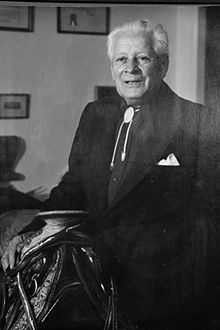Duncan Renaldo

Biography
Early years

Renaldo told some interviewers that he actually did not know where he was born.[2] Various sources claim that he was born in Oancea, Galați County, Romania as Vasile Dumitru V. Couyanos or Basil Couyanos.[3][4][5] Renaldo apparently never knew his biological parents and was raised in several European countries.[3] His birthplace has been generally stated as Romania and he said his first childhood memories were in Romania.[3]
He emigrated to America in the 1920s. Failing to support himself as a portrait painter, he tried producing short films. He eventually took up acting and signed with MGM in 1928 where he worked in at least two major films, The Bridge of San Luis Rey and Trader Horn. The latter film was shot on location in Africa and is notorious for adventures that rivaled the source book's and film's plot of a "great white hunter" and a white blonde jungle queen, the lost daughter of a missionary. One crew member was taken by a crocodile and another killed by a charging rhino. Many crew and stars were stricken with malaria but Renaldo told one interviewer in 1971 that he never contracted the parasite because he took a hunter's advice to "race the blood" with a shot of whiskey in the morning and another at dusk.
In 1934, he was arrested for illegal entry into the United States, but eventually was pardoned by President Franklin Roosevelt and returned to acting.[6] He found minor roles at Republic Studios and other Poverty Row studios until he convinced Republic head Herbert Yates in 1939 to introduce a Latin cowboy into The Three Mesquiteers series. The character only lasted a year, though, and Renaldo was back to minor roles in B-films, for example Tiger Fangs (1943). Renaldo did play some roles in mainstream films as well, including in Spawn of the North (1938) with George Raft, Henry Fonda and John Barrymore; and For Whom the Bell Tolls with Gary Cooper and Ingrid Bergman. He was also a producer, writer and director.
Television star

In the late 1940s, Renaldo starred in several Hollywood Westerns as The Cisco Kid, and in 1950, he began playing the role in a popular television series that ran until 1956. In the age of black-and-white television, the show was filmed in color. As Cisco, Renaldo roamed the Old West on a black-and-white horse named Diablo, accompanied by his constant companion, Pancho, played by Leo Carrillo, who was 24 years Renaldo's senior. The Cisco Kid always helped where needed, and unlike most Western heroes, rarely killed anyone.
Renaldo illustrated a book of poetry by Moreton B. Price titled Drifter's Dreams. His illustrations are ink sketches of idyllic scenes, primarily seascapes and landscapes. He also painted in oils. Two of his large paintings of members of the Maasai tribe whom he met in Kenya while filming "Trader Horn" were prominently displayed in his Santa Barbara home in 1971.
Death
Renaldo died of lung cancer in 1980, aged 76, in Goleta, California. His interment took place in Calvary Cemetery in Santa Barbara, California.
Legacy
For his contributions to the television industry, Renaldo has a star on the Hollywood Walk of Fame at 1680 Vine Street.[1] He is pictured with the band War on their 1974 album, War Live, which includes the group's 1973 song, "The Cisco Kid."
Partial filmography
- Down Mexico Way (1941)
- Two Years Before the Mast (1946)
References
- ↑ 1.0 1.1 "Hollywood Star Walk Duncan Renaldo". Los Angeles Times. Retrieved 2010-04-16.
- ↑ "Duncan Renaldo". www.b-westerns.com. Retrieved 2010-04-16.
- ↑ 3.0 3.1 3.2 "United States 9th Circuit Court of Appeals Reports - December 13, 1933". Leagle.com. Retrieved 2010-06-19.
- ↑ "Renaldo Applies For Citizenship". The Spokesman Chronicle. 9 June 1936. Retrieved 2010-05-11.
- ↑ "The Cisco Kid Duncan Renaldo is dead". Ellensburg Daily Record. 4 September 1980. Retrieved 2010-05-11.
- ↑ "DUNCAN RENALDO (1904–1980)". noblebandits.asu.edu. Retrieved 2010-04-16.